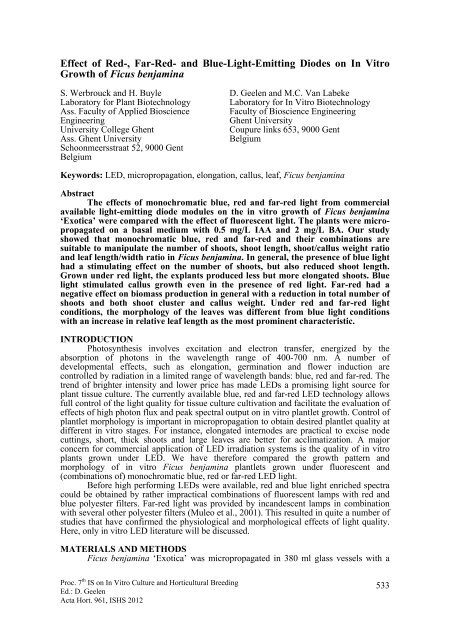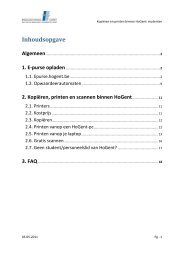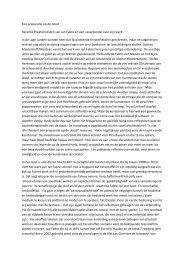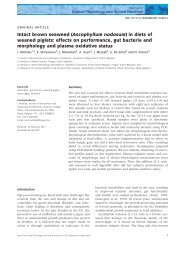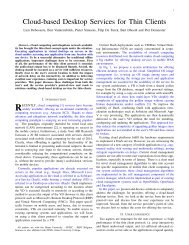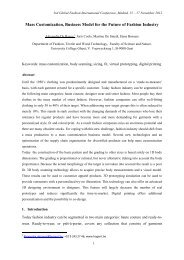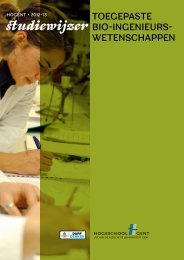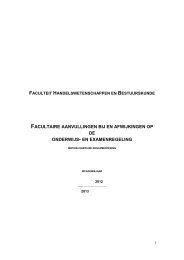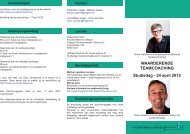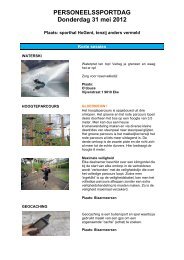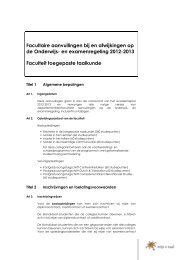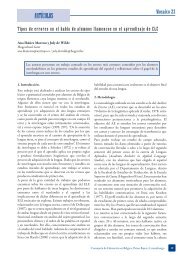Effect of Red-, Far-Red- and Blue-Light-Emitting Diodes on In Vitro ...
Effect of Red-, Far-Red- and Blue-Light-Emitting Diodes on In Vitro ...
Effect of Red-, Far-Red- and Blue-Light-Emitting Diodes on In Vitro ...
Create successful ePaper yourself
Turn your PDF publications into a flip-book with our unique Google optimized e-Paper software.
<str<strong>on</strong>g>Effect</str<strong>on</strong>g> <str<strong>on</strong>g>of</str<strong>on</strong>g> <str<strong>on</strong>g>Red</str<strong>on</strong>g>-, <str<strong>on</strong>g>Far</str<strong>on</strong>g>-<str<strong>on</strong>g>Red</str<strong>on</strong>g>- <str<strong>on</strong>g>and</str<strong>on</strong>g> <str<strong>on</strong>g>Blue</str<strong>on</strong>g>-<str<strong>on</strong>g>Light</str<strong>on</strong>g>-<str<strong>on</strong>g>Emitting</str<strong>on</strong>g> <str<strong>on</strong>g>Diodes</str<strong>on</strong>g> <strong>on</strong> <strong>In</strong> <strong>Vitro</strong><br />
Growth <str<strong>on</strong>g>of</str<strong>on</strong>g> Ficus benjamina<br />
S. Werbrouck <str<strong>on</strong>g>and</str<strong>on</strong>g> H. Buyle<br />
Laboratory for Plant Biotechnology<br />
Ass. Faculty <str<strong>on</strong>g>of</str<strong>on</strong>g> Applied Bioscience<br />
Engineering<br />
University College Ghent<br />
Ass. Ghent University<br />
Scho<strong>on</strong>meersstraat 52, 9000 Gent<br />
Belgium<br />
D. Geelen <str<strong>on</strong>g>and</str<strong>on</strong>g> M.C. Van Labeke<br />
Laboratory for <strong>In</strong> <strong>Vitro</strong> Biotechnology<br />
Faculty <str<strong>on</strong>g>of</str<strong>on</strong>g> Bioscience Engineering<br />
Ghent University<br />
Coupure links 653, 9000 Gent<br />
Belgium<br />
Keywords: LED, micropropagati<strong>on</strong>, el<strong>on</strong>gati<strong>on</strong>, callus, leaf, Ficus benjamina<br />
Abstract<br />
The effects <str<strong>on</strong>g>of</str<strong>on</strong>g> m<strong>on</strong>ochromatic blue, red <str<strong>on</strong>g>and</str<strong>on</strong>g> far-red light from commercial<br />
available light-emitting diode modules <strong>on</strong> the in vitro growth <str<strong>on</strong>g>of</str<strong>on</strong>g> Ficus benjamina<br />
‘Exotica’ were compared with the effect <str<strong>on</strong>g>of</str<strong>on</strong>g> fluorescent light. The plants were micropropagated<br />
<strong>on</strong> a basal medium with 0.5 mg/L IAA <str<strong>on</strong>g>and</str<strong>on</strong>g> 2 mg/L BA. Our study<br />
showed that m<strong>on</strong>ochromatic blue, red <str<strong>on</strong>g>and</str<strong>on</strong>g> far-red <str<strong>on</strong>g>and</str<strong>on</strong>g> their combinati<strong>on</strong>s are<br />
suitable to manipulate the number <str<strong>on</strong>g>of</str<strong>on</strong>g> shoots, shoot length, shoot/callus weight ratio<br />
<str<strong>on</strong>g>and</str<strong>on</strong>g> leaf length/width ratio in Ficus benjamina. <strong>In</strong> general, the presence <str<strong>on</strong>g>of</str<strong>on</strong>g> blue light<br />
had a stimulating effect <strong>on</strong> the number <str<strong>on</strong>g>of</str<strong>on</strong>g> shoots, but also reduced shoot length.<br />
Grown under red light, the explants produced less but more el<strong>on</strong>gated shoots. <str<strong>on</strong>g>Blue</str<strong>on</strong>g><br />
light stimulated callus growth even in the presence <str<strong>on</strong>g>of</str<strong>on</strong>g> red light. <str<strong>on</strong>g>Far</str<strong>on</strong>g>-red had a<br />
negative effect <strong>on</strong> biomass producti<strong>on</strong> in general with a reducti<strong>on</strong> in total number <str<strong>on</strong>g>of</str<strong>on</strong>g><br />
shoots <str<strong>on</strong>g>and</str<strong>on</strong>g> both shoot cluster <str<strong>on</strong>g>and</str<strong>on</strong>g> callus weight. Under red <str<strong>on</strong>g>and</str<strong>on</strong>g> far-red light<br />
c<strong>on</strong>diti<strong>on</strong>s, the morphology <str<strong>on</strong>g>of</str<strong>on</strong>g> the leaves was different from blue light c<strong>on</strong>diti<strong>on</strong>s<br />
with an increase in relative leaf length as the most prominent characteristic.<br />
INTRODUCTION<br />
Photosynthesis involves excitati<strong>on</strong> <str<strong>on</strong>g>and</str<strong>on</strong>g> electr<strong>on</strong> transfer, energized by the<br />
absorpti<strong>on</strong> <str<strong>on</strong>g>of</str<strong>on</strong>g> phot<strong>on</strong>s in the wavelength range <str<strong>on</strong>g>of</str<strong>on</strong>g> 400-700 nm. A number <str<strong>on</strong>g>of</str<strong>on</strong>g><br />
developmental effects, such as el<strong>on</strong>gati<strong>on</strong>, germinati<strong>on</strong> <str<strong>on</strong>g>and</str<strong>on</strong>g> flower inducti<strong>on</strong> are<br />
c<strong>on</strong>trolled by radiati<strong>on</strong> in a limited range <str<strong>on</strong>g>of</str<strong>on</strong>g> wavelength b<str<strong>on</strong>g>and</str<strong>on</strong>g>s: blue, red <str<strong>on</strong>g>and</str<strong>on</strong>g> far-red. The<br />
trend <str<strong>on</strong>g>of</str<strong>on</strong>g> brighter intensity <str<strong>on</strong>g>and</str<strong>on</strong>g> lower price has made LEDs a promising light source for<br />
plant tissue culture. The currently available blue, red <str<strong>on</strong>g>and</str<strong>on</strong>g> far-red LED technology allows<br />
full c<strong>on</strong>trol <str<strong>on</strong>g>of</str<strong>on</strong>g> the light quality for tissue culture cultivati<strong>on</strong> <str<strong>on</strong>g>and</str<strong>on</strong>g> facilitate the evaluati<strong>on</strong> <str<strong>on</strong>g>of</str<strong>on</strong>g><br />
effects <str<strong>on</strong>g>of</str<strong>on</strong>g> high phot<strong>on</strong> flux <str<strong>on</strong>g>and</str<strong>on</strong>g> peak spectral output <strong>on</strong> in vitro plantlet growth. C<strong>on</strong>trol <str<strong>on</strong>g>of</str<strong>on</strong>g><br />
plantlet morphology is important in micropropagati<strong>on</strong> to obtain desired plantlet quality at<br />
different in vitro stages. For instance, el<strong>on</strong>gated internodes are practical to excise node<br />
cuttings, short, thick shoots <str<strong>on</strong>g>and</str<strong>on</strong>g> large leaves are better for acclimatizati<strong>on</strong>. A major<br />
c<strong>on</strong>cern for commercial applicati<strong>on</strong> <str<strong>on</strong>g>of</str<strong>on</strong>g> LED irradiati<strong>on</strong> systems is the quality <str<strong>on</strong>g>of</str<strong>on</strong>g> in vitro<br />
plants grown under LED. We have therefore compared the growth pattern <str<strong>on</strong>g>and</str<strong>on</strong>g><br />
morphology <str<strong>on</strong>g>of</str<strong>on</strong>g> in vitro Ficus benjamina plantlets grown under fluorescent <str<strong>on</strong>g>and</str<strong>on</strong>g><br />
(combinati<strong>on</strong>s <str<strong>on</strong>g>of</str<strong>on</strong>g>) m<strong>on</strong>ochromatic blue, red or far-red LED light.<br />
Before high performing LEDs were available, red <str<strong>on</strong>g>and</str<strong>on</strong>g> blue light enriched spectra<br />
could be obtained by rather impractical combinati<strong>on</strong>s <str<strong>on</strong>g>of</str<strong>on</strong>g> fluorescent lamps with red <str<strong>on</strong>g>and</str<strong>on</strong>g><br />
blue polyester filters. <str<strong>on</strong>g>Far</str<strong>on</strong>g>-red light was provided by inc<str<strong>on</strong>g>and</str<strong>on</strong>g>escent lamps in combinati<strong>on</strong><br />
with several other polyester filters (Muleo et al., 2001). This resulted in quite a number <str<strong>on</strong>g>of</str<strong>on</strong>g><br />
studies that have c<strong>on</strong>firmed the physiological <str<strong>on</strong>g>and</str<strong>on</strong>g> morphological effects <str<strong>on</strong>g>of</str<strong>on</strong>g> light quality.<br />
Here, <strong>on</strong>ly in vitro LED literature will be discussed.<br />
MATERIALS AND METHODS<br />
Ficus benjamina ‘Exotica’ was micropropagated in 380 ml glass vessels with a<br />
Proc. 7 th IS <strong>on</strong> <strong>In</strong> <strong>Vitro</strong> Culture <str<strong>on</strong>g>and</str<strong>on</strong>g> Horticultural Breeding<br />
Ed.: D. Geelen<br />
Acta Hort. 961, ISHS 2012<br />
533
screw <strong>on</strong> polycarb<strong>on</strong>ate lid <strong>on</strong> a basal medium (BM) c<strong>on</strong>taining Murashige <str<strong>on</strong>g>and</str<strong>on</strong>g> Skoog<br />
(1962) macroelements, Nitch <str<strong>on</strong>g>and</str<strong>on</strong>g> Nitch (1969) microelements, 35 mg/L NaFeEDTA,<br />
100 mg/L myo-inositol, 0.4 ml/L thiamine HCl, 120 mg/L adeninesulfate, 170 mg/L<br />
NaH 2 PO 4 , 7 g/L agar, 15 g/L sucrose, 0.5 mg/L IAA, 2 mg/L BA (pH 5.8 before autoclaving).<br />
Each culture vessel c<strong>on</strong>tained 100 ml autoclaved medium (120°C, 30 min) with<br />
6 uniform shoots with detached leaves. To allow high transmissi<strong>on</strong>, the plastic screw-<strong>on</strong><br />
lids <str<strong>on</strong>g>of</str<strong>on</strong>g> the vessels where replaced by polycarb<strong>on</strong>ate petri dishes. Each vessel was packed<br />
in low density polyethylene foil.<br />
The cultures were maintained at 23±2°C under a 16 hour photoperiod. C<strong>on</strong>trol<br />
treatment was cool fluorescent light (FL), provided by PHILIPS master TLD 36W 830<br />
Reflex ECO (45 µmol m -2 s -1 PAR) or following combinati<strong>on</strong>s <str<strong>on</strong>g>of</str<strong>on</strong>g> blue (B, 454 nm), red<br />
(R 660 nm) <str<strong>on</strong>g>and</str<strong>on</strong>g> far red (FR 745 nm) light emitting diodes (Fig. 1): 100% R (=R), 100% B<br />
(=B), 100% FR (=FR), 50% B + 50% R (=BR), 50% B + 50% FR (=BFR), 50% R + 50%<br />
FR (=RFR). By means <str<strong>on</strong>g>of</str<strong>on</strong>g> dimmers <str<strong>on</strong>g>and</str<strong>on</strong>g> a JAZ light meter (Ocean Optics) total PFD was<br />
adjusted to 40 µmol phot<strong>on</strong>s m -2 s -1 . The culture racks were divided in boxes with white<br />
walls <str<strong>on</strong>g>and</str<strong>on</strong>g> a white door (Fig. 1), in which Philips GreenPower LED Research Modules<br />
were mounted. After 10 weeks under these c<strong>on</strong>diti<strong>on</strong>s, shoot cluster <str<strong>on</strong>g>and</str<strong>on</strong>g> callus weight,<br />
shoot number <str<strong>on</strong>g>and</str<strong>on</strong>g> length were measured. Shoots were counted in three classes: 2 cm. Per explant, length <str<strong>on</strong>g>and</str<strong>on</strong>g> width <str<strong>on</strong>g>of</str<strong>on</strong>g> all leaves <str<strong>on</strong>g>of</str<strong>on</strong>g> <strong>on</strong>e r<str<strong>on</strong>g>and</str<strong>on</strong>g>om shoot per<br />
vessel were measured by image analysis. The experiment was replicated three times, with<br />
9 vessels per light treatment for each replicate. Data <str<strong>on</strong>g>of</str<strong>on</strong>g> the treatments were subjected to<br />
<strong>on</strong>e way ANOVA, mean separati<strong>on</strong> was d<strong>on</strong>e by Tukey’s HSD test (p=0.05).<br />
RESULTS AND DISCUSSION<br />
Shoot Number per Explant <str<strong>on</strong>g>and</str<strong>on</strong>g> Shoot Size<br />
Under R, the explants produced less but more el<strong>on</strong>gated shoots (Fig. 3) then under<br />
B <str<strong>on</strong>g>and</str<strong>on</strong>g> FL (Table 1). The presence <str<strong>on</strong>g>of</str<strong>on</strong>g> blue light had a stimulating effect <strong>on</strong> the number <str<strong>on</strong>g>of</str<strong>on</strong>g><br />
shoots. More shoots means smaller shoots. Most shoots were recorded under B, RB <str<strong>on</strong>g>and</str<strong>on</strong>g><br />
FL, which indicates that, for this parameter, blue light ‘dominates’ red light R when used<br />
together. B also dominates FR. FR, R <str<strong>on</strong>g>and</str<strong>on</strong>g> RFR were disadvantageous for the total number<br />
<str<strong>on</strong>g>of</str<strong>on</strong>g> shoots.<br />
These results are in line with a number <str<strong>on</strong>g>of</str<strong>on</strong>g> recent reports. Mo<strong>on</strong> et al. (2006)<br />
analyzed the effects <str<strong>on</strong>g>of</str<strong>on</strong>g> R <str<strong>on</strong>g>and</str<strong>on</strong>g> B <strong>on</strong> in vitro Tripterospermum jap<strong>on</strong>icum. The l<strong>on</strong>gest<br />
nodes were observed from R-treated plants, the shortest from the B-treatment. Although<br />
plants were tallest under red light, their growth was fragile due to excessive internodal<br />
el<strong>on</strong>gati<strong>on</strong>. Vitis vinifera showed a significantly stimulated shoot el<strong>on</strong>gati<strong>on</strong> under R<br />
whereas B <str<strong>on</strong>g>and</str<strong>on</strong>g> the combinati<strong>on</strong> <str<strong>on</strong>g>of</str<strong>on</strong>g> B <str<strong>on</strong>g>and</str<strong>on</strong>g> R were associated with short shoots (Heo et al.,<br />
2006). Chrysanthemum shoots showed largest stem length under R <str<strong>on</strong>g>and</str<strong>on</strong>g> RFR. Also here,<br />
the presence <str<strong>on</strong>g>of</str<strong>on</strong>g> B reduced stem length (Kim et al., 2004). All these reports deal with<br />
plants grown <strong>on</strong> cytokinin free medium <str<strong>on</strong>g>and</str<strong>on</strong>g> as a c<strong>on</strong>sequence no data about shoot<br />
proliferati<strong>on</strong> is available. Poudel et al. (2008) showed that, in combinati<strong>on</strong> with 0,5 mg/L<br />
BA <str<strong>on</strong>g>and</str<strong>on</strong>g> 0.01 mg/L NAA, plant height <str<strong>on</strong>g>and</str<strong>on</strong>g> internode length <str<strong>on</strong>g>of</str<strong>on</strong>g> Vitis was significantly<br />
l<strong>on</strong>ger in plants cultured under R. Shoot length under B <str<strong>on</strong>g>and</str<strong>on</strong>g> FL were not different. <strong>In</strong> this<br />
study there was no effect <strong>on</strong> shoot number, in c<strong>on</strong>trast with the findings <str<strong>on</strong>g>of</str<strong>on</strong>g> Chée (1986)<br />
who found a higher shoot producti<strong>on</strong> under B. Li et al. (2010) reported that stem length<br />
<str<strong>on</strong>g>and</str<strong>on</strong>g> sec<strong>on</strong>d internode length <str<strong>on</strong>g>of</str<strong>on</strong>g> Gossypium hirsitum were largest in plantlets cultured<br />
under the BR <str<strong>on</strong>g>and</str<strong>on</strong>g> B, followed by R <str<strong>on</strong>g>and</str<strong>on</strong>g> FL.<br />
By means <str<strong>on</strong>g>of</str<strong>on</strong>g> phytochrome signaling, plants sense an increase in FR radiati<strong>on</strong><br />
caused by the reflecti<strong>on</strong> <str<strong>on</strong>g>of</str<strong>on</strong>g> FR by neighboring plants <str<strong>on</strong>g>and</str<strong>on</strong>g> resp<strong>on</strong>d with increased<br />
el<strong>on</strong>gati<strong>on</strong> (Ballaré, 1999). This effect <str<strong>on</strong>g>of</str<strong>on</strong>g> FR is not observed in our experiments with<br />
Ficus benjamina. FR does not drive photosynthesis, so this could be the reas<strong>on</strong> why<br />
plants grown under pure FR are small, in spite <str<strong>on</strong>g>of</str<strong>on</strong>g> the available sucrose in the medium.<br />
Generally, reduced levels <str<strong>on</strong>g>of</str<strong>on</strong>g> blue light occur when the canopy begins to close <str<strong>on</strong>g>and</str<strong>on</strong>g> this<br />
drop causes a reducti<strong>on</strong> <str<strong>on</strong>g>of</str<strong>on</strong>g> stem el<strong>on</strong>gati<strong>on</strong> (Ballaré, 1999). <str<strong>on</strong>g>Blue</str<strong>on</strong>g> light is perceived by<br />
534
cryptochrome. The mode <str<strong>on</strong>g>of</str<strong>on</strong>g> CRY signal transducti<strong>on</strong> towards etiolati<strong>on</strong> has recently been<br />
reviewed by Liu et al. (2011).<br />
Shoot Cluster <str<strong>on</strong>g>and</str<strong>on</strong>g> Callus Weight<br />
The positive effect <strong>on</strong> shoot cluster weight <str<strong>on</strong>g>of</str<strong>on</strong>g> red light was counteracted by the<br />
overall negative effect <str<strong>on</strong>g>of</str<strong>on</strong>g> blue light (Table 2). The highest callus weight was observed<br />
under B <str<strong>on</strong>g>and</str<strong>on</strong>g> RB, followed by FL. <str<strong>on</strong>g>Blue</str<strong>on</strong>g> light str<strong>on</strong>gly stimulated callus growth <str<strong>on</strong>g>and</str<strong>on</strong>g> this<br />
was not prevented by red light applicati<strong>on</strong>. The presence <str<strong>on</strong>g>of</str<strong>on</strong>g> FR had a negative effect <strong>on</strong><br />
both shoot cluster <str<strong>on</strong>g>and</str<strong>on</strong>g> callus weight. The negative effect <str<strong>on</strong>g>of</str<strong>on</strong>g> B <strong>on</strong> shoot weight <str<strong>on</strong>g>and</str<strong>on</strong>g> its<br />
positive effect <strong>on</strong> callus growth is reflected in the low calculated shoot/callus weight ratio<br />
(Table 2). These results show that, in all c<strong>on</strong>diti<strong>on</strong>s, blue light had a negative effect <strong>on</strong> the<br />
weight proporti<strong>on</strong> <str<strong>on</strong>g>of</str<strong>on</strong>g> the shoots. Also FL c<strong>on</strong>tains blue light <str<strong>on</strong>g>and</str<strong>on</strong>g> yields a low shoot/callus<br />
weight ratio.<br />
Analogue experiments in Chrysanthemum showed that in vitro plants performed<br />
poorly under BFR <str<strong>on</strong>g>and</str<strong>on</strong>g> produced the lowest fresh <str<strong>on</strong>g>and</str<strong>on</strong>g> dry weight under these light<br />
c<strong>on</strong>diti<strong>on</strong>s. <strong>In</strong> c<strong>on</strong>trast with our results, BR <str<strong>on</strong>g>and</str<strong>on</strong>g> FL gave the highest fresh <str<strong>on</strong>g>and</str<strong>on</strong>g> dry weight<br />
(Kim et al., 2004). <strong>In</strong> micropropagated Tripterospermum jap<strong>on</strong>icum (Mo<strong>on</strong> et al., 2006),<br />
B gave the lowest fresh weight <str<strong>on</strong>g>and</str<strong>on</strong>g> the fresh weight recorded under BR overtook those<br />
under R <str<strong>on</strong>g>and</str<strong>on</strong>g> FL. The same negative effect <str<strong>on</strong>g>of</str<strong>on</strong>g> B <strong>on</strong> fresh <str<strong>on</strong>g>and</str<strong>on</strong>g> dry weight <str<strong>on</strong>g>of</str<strong>on</strong>g> B was recorded<br />
in in vitro Vitis by Heo et al. (2006). Callus fracti<strong>on</strong> was not determined in these studies<br />
since cytokinins were not supplemented to the medium.<br />
Leaf Length/Width Ratio<br />
The presence <str<strong>on</strong>g>of</str<strong>on</strong>g> R <str<strong>on</strong>g>and</str<strong>on</strong>g> FR yields narrow leaves, in c<strong>on</strong>trast to B that c<strong>on</strong>fers oval<br />
leaves, just as FL (Table 3). When combined with red or far red light, blue light can <strong>on</strong>ly<br />
level the effect <str<strong>on</strong>g>of</str<strong>on</strong>g> red light, not that <str<strong>on</strong>g>of</str<strong>on</strong>g> far red. This is illustrated by the smaller ratio for<br />
B, RB <str<strong>on</strong>g>and</str<strong>on</strong>g> FL <str<strong>on</strong>g>and</str<strong>on</strong>g> is reflected in the observati<strong>on</strong>s <str<strong>on</strong>g>of</str<strong>on</strong>g> Shin et al. (2008) in micropropagated<br />
Doritaenopsis, where leaf length increased for plants grown under R compared to B, BR<br />
<str<strong>on</strong>g>and</str<strong>on</strong>g> FL.<br />
CONCLUSION<br />
Our study shows that m<strong>on</strong>ochromatic blue, red <str<strong>on</strong>g>and</str<strong>on</strong>g> far-red <str<strong>on</strong>g>and</str<strong>on</strong>g> their combinati<strong>on</strong>s<br />
are suitable to manipulate the number <str<strong>on</strong>g>of</str<strong>on</strong>g> shoots, shoot length, shoot/callus weight ratio<br />
<str<strong>on</strong>g>and</str<strong>on</strong>g> leaf length/width ratio in Ficus benjamina. <strong>In</strong> general, the presence <str<strong>on</strong>g>of</str<strong>on</strong>g> blue light had a<br />
stimulating effect <strong>on</strong> the number <str<strong>on</strong>g>of</str<strong>on</strong>g> shoots but also reduced shoot length. Grown under<br />
red light, the explants produced less but more el<strong>on</strong>gated shoots. <str<strong>on</strong>g>Blue</str<strong>on</strong>g> light obviously<br />
stimulates callus growth <str<strong>on</strong>g>and</str<strong>on</strong>g> this could hardly be levelled by red light. FR had a negative<br />
effect <strong>on</strong> total number <str<strong>on</strong>g>of</str<strong>on</strong>g> shoots <str<strong>on</strong>g>and</str<strong>on</strong>g> both shoot cluster <str<strong>on</strong>g>and</str<strong>on</strong>g> callus weight. The presence <str<strong>on</strong>g>of</str<strong>on</strong>g><br />
R <str<strong>on</strong>g>and</str<strong>on</strong>g> FR yields l<strong>on</strong>ger leaves, in c<strong>on</strong>trast to the rounder leaves that develop under blue<br />
light.<br />
ACKNOWLEDGEMENTS<br />
This research was supported by the Flemish Government (IWT80122) <str<strong>on</strong>g>and</str<strong>on</strong>g> private<br />
tissue culture companies. The authors also thank the framework <str<strong>on</strong>g>of</str<strong>on</strong>g> the “Associatie<strong>on</strong>derzoeksgroep<br />
Primaire Plantaardige Productie”.<br />
Literature Cited<br />
Ballaré, C.L. 1999. Keeping up with the neighbours: phytochrome sensing <str<strong>on</strong>g>and</str<strong>on</strong>g> other<br />
signaling mechanisms. Trends Plant Sci. 4:97-102.<br />
Chée, R. 1986. <strong>In</strong> vitro culture <str<strong>on</strong>g>of</str<strong>on</strong>g> Vitis: the effects <str<strong>on</strong>g>of</str<strong>on</strong>g> light spectrum, manganese sulfate<br />
<str<strong>on</strong>g>and</str<strong>on</strong>g> potassium iodide <strong>on</strong> morphogenesis. Plant Cell Tiss. Org. Cult. 1:121-134.<br />
Heo, J.W., Shin, K.S., Kim, S.K. <str<strong>on</strong>g>and</str<strong>on</strong>g> Paek, K.Y. 2006. <str<strong>on</strong>g>Light</str<strong>on</strong>g> quality affects in vitro<br />
growth <str<strong>on</strong>g>of</str<strong>on</strong>g> grape ‘Teleki 5BB7’. J. Plant Biol. 49:276-280.<br />
Muleo, R., Morini, S. <str<strong>on</strong>g>and</str<strong>on</strong>g> Casano, S. 2001. Photoregulati<strong>on</strong> <str<strong>on</strong>g>of</str<strong>on</strong>g> growth <str<strong>on</strong>g>and</str<strong>on</strong>g> branching <str<strong>on</strong>g>of</str<strong>on</strong>g><br />
plum shoots: physiological acti<strong>on</strong> <str<strong>on</strong>g>of</str<strong>on</strong>g> two photosystems. <strong>In</strong> <strong>Vitro</strong> Cell. Dev. Biol. Plant<br />
535
37:609-617.<br />
Kim, S., Hahn, E.J., Heo, J.W. <str<strong>on</strong>g>and</str<strong>on</strong>g> Paek, K.Y. 2004. <str<strong>on</strong>g>Effect</str<strong>on</strong>g> <str<strong>on</strong>g>of</str<strong>on</strong>g> LEDs <strong>on</strong> net photosynthetic<br />
rate, growth <str<strong>on</strong>g>and</str<strong>on</strong>g> leaf stomata <str<strong>on</strong>g>of</str<strong>on</strong>g> chrysanthemum plantlets in vitro. Sci. Hort.<br />
101:143-151.<br />
Huimin, L., Zhigang, X. <str<strong>on</strong>g>and</str<strong>on</strong>g> Canming, T. 2010. <str<strong>on</strong>g>Effect</str<strong>on</strong>g> <str<strong>on</strong>g>of</str<strong>on</strong>g> light-emitting diodes <strong>on</strong> growth<br />
<str<strong>on</strong>g>and</str<strong>on</strong>g> morphogenesis <str<strong>on</strong>g>of</str<strong>on</strong>g> upl<str<strong>on</strong>g>and</str<strong>on</strong>g> cott<strong>on</strong> (Gossypium hirsutum L.) plantlets in vitro. Plant<br />
Cell Tiss. Organ Cult. 103:155-163.<br />
Liu, H., Liu, B., Zhao, C., Pepper, M. <str<strong>on</strong>g>and</str<strong>on</strong>g> Lin, C. 2011. The acti<strong>on</strong> mechanisms <str<strong>on</strong>g>of</str<strong>on</strong>g> plant<br />
cryptochromes. Trends in Plant Science (in press).<br />
Mo<strong>on</strong>, H.K., Park, S.Y., Kim, Y.W. <str<strong>on</strong>g>and</str<strong>on</strong>g> Kim, C.S. 2006. Growth <str<strong>on</strong>g>of</str<strong>on</strong>g> Tsuru-rindo<br />
(Tripterospermum jap<strong>on</strong>icum) cultured in vitro under various sources <str<strong>on</strong>g>of</str<strong>on</strong>g> light-emitting<br />
diode (LED) irradiati<strong>on</strong>. J. Plant Biol. 49:174-179.<br />
Murashige, T. <str<strong>on</strong>g>and</str<strong>on</strong>g> Skoog, F. 1962. A revised medium for rapid growth <str<strong>on</strong>g>and</str<strong>on</strong>g> bioassays<br />
with tobacco tissue cultures. Physiol. Plant. 15:473-497.<br />
Nitch, J.P. <str<strong>on</strong>g>and</str<strong>on</strong>g> Nitch, C. 1969. Haploid plants from pollen grains. Science 163:85-87.<br />
Shin, K.S., Murthy, H.N., Heo, J.W., Hahn E.J. <str<strong>on</strong>g>and</str<strong>on</strong>g> Paek, K.Y. 2008. The effect <str<strong>on</strong>g>of</str<strong>on</strong>g> light<br />
quality <strong>on</strong> the growth <str<strong>on</strong>g>and</str<strong>on</strong>g> development <str<strong>on</strong>g>of</str<strong>on</strong>g> in vitro cultured Doritaenopsis plants. Acta<br />
Physiol. Plant. 30:339-343.<br />
Tables<br />
Table 1. <str<strong>on</strong>g>Effect</str<strong>on</strong>g> <str<strong>on</strong>g>of</str<strong>on</strong>g> light spectrum <strong>on</strong> number <str<strong>on</strong>g>of</str<strong>on</strong>g> small (2 cm) shoots. Means within <strong>on</strong>e column followed by the same letters are not<br />
significant different (Tukey, 95%).<br />
Spectrum<br />
Shoot class<br />
2 cm<br />
Total<br />
B 8.7 ab 0.5 b 0.1 b 9.3 ab<br />
R 3.3 e 1.1 ab 1.4 a 5.8 bc<br />
FR 3.0 e 0.9 ab 0.2 b 4.0 c<br />
RB 11.7 a 0.6 b 0.0 b 12.3 a<br />
BFR 5.6 cd 1.0 ab 0.2 b 6.8 b<br />
RFR 3.9 de 1.7 a 1.0 a 6.6 bc<br />
FL 6.5 bc 0.3 b 0.0 b 6.8 b<br />
Table 2. <str<strong>on</strong>g>Effect</str<strong>on</strong>g> <str<strong>on</strong>g>of</str<strong>on</strong>g> light spectrum <strong>on</strong> shoot <str<strong>on</strong>g>and</str<strong>on</strong>g> callus weight <str<strong>on</strong>g>and</str<strong>on</strong>g> their ratio. Means within<br />
<strong>on</strong>e column followed by the same letters are not significant different (Tukey, 95%).<br />
Spectrum<br />
Shoot weight Callus weight<br />
(mg) (mg)<br />
Shoot weight/callus weight<br />
B 229 b 313 ab 0.73<br />
R 525 a 171 cd 3.07<br />
FR 184 b 54 d 3.41<br />
RB 235 b 366 a 0.64<br />
BFR 137 b 129 cd 1.06<br />
RFR 512 a 190 c 2.69<br />
FL 170 b 215 bc 0.79<br />
536
Table 3. <str<strong>on</strong>g>Effect</str<strong>on</strong>g> <str<strong>on</strong>g>of</str<strong>on</strong>g> light spectrum <strong>on</strong> leaf length, width <str<strong>on</strong>g>and</str<strong>on</strong>g> ratio as measured <strong>on</strong> <strong>on</strong>e shoot<br />
per explant. Means within <strong>on</strong>e column followed by the same letters are not significant<br />
different (Tukey, 95%).<br />
Leaf length Leaf width<br />
Spectrum<br />
(mm) (mm)<br />
Leaf length/width ratio<br />
B 7.5 a 5.1 a 1.50 b<br />
R 6.0 b 3.4 de 1.81 a<br />
FR 4.2 c 2.6 e 1.60 ab<br />
RB 7.8 a 5.3 a 1.50 b<br />
BFR 7.4 ab 4.3 bc 1.74 a<br />
RFR 6.8 ab 3.9 cd 1.71 ab<br />
FL 7.3 ab 4.8 ab 1.52 b<br />
Figures<br />
2,50<br />
Energy (µmol/m².s)<br />
2,00<br />
1,50<br />
1,00<br />
0,50<br />
R<br />
B<br />
FR<br />
FL<br />
0,00<br />
300 400 500 600 700 800<br />
wavelength (nm)<br />
Fig. 1. Spectrum <str<strong>on</strong>g>of</str<strong>on</strong>g> fluorescent light, blue, red <str<strong>on</strong>g>and</str<strong>on</strong>g> far-red Philips Research LED.<br />
537
Fig. 2. Culture cells with white walls <str<strong>on</strong>g>and</str<strong>on</strong>g> door, c<strong>on</strong>taining 18 vessels covered with a petri<br />
dish lid <str<strong>on</strong>g>and</str<strong>on</strong>g> polyethylene foil.<br />
Fig. 3. <str<strong>on</strong>g>Effect</str<strong>on</strong>g> <str<strong>on</strong>g>of</str<strong>on</strong>g> B, R <str<strong>on</strong>g>and</str<strong>on</strong>g> FR light <strong>on</strong> the development <str<strong>on</strong>g>of</str<strong>on</strong>g> a centrally depicted defoliated<br />
Ficus benjamina explant, visualized by sample plants (arrows: left = B; right = R;<br />
under = FR).<br />
538


